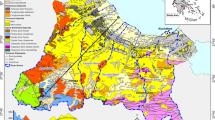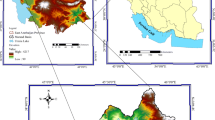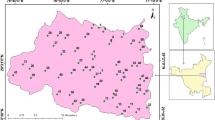Abstract
Continuous depletion of groundwater levels from deliberate and uncontrolled exploitation of groundwater resources lead to the severe problems in arid and semi-arid hard-rock regions of the world. Geostatistics and geographic information system (GIS) have been proved as successful tools for efficient planning and management of the groundwater resources. The present study demonstrated applicability of geostatistics and GIS to understand spatial and temporal behavior of groundwater levels in a semi-arid hard-rock aquifer of Western India. Monthly groundwater levels of 50 sites in the study area for 36-month period (May 2006 to June 2009; excluding 3 months) were analyzed to find spatial autocorrelation and variances in the groundwater levels. Experimental variogram of the observed groundwater levels was computed at 750-m lag distance interval and the four most-widely used geostatistical models were fitted to the experimental variogram. The best-fit geostatistical model was selected by using two goodness-of-fit criteria, i.e., root mean square error (RMSE) and correlation coefficient (r). Then spatial maps of the groundwater levels were prepared through kriging technique by means of the best-fit geostatistical model. Results of two spatial statistics (Geary’s C and Moran’s I) indicated a strong positive autocorrelation in the groundwater levels within 3-km lag distance. It is emphasized that the spatial statistics are promising tools for geostatistical modeling, which help choose appropriate values of model parameters. Nugget-sill ratio (<0.25) revealed that the groundwater levels have strong spatial dependence in the area. The statistical indicators (RMSE and r) suggested that any of the three geostatistical models, i.e., spherical, circular, and exponential, can be selected as the best-fit model for reliable and accurate spatial interpolation. However, exponential model is used as the best-fit model in the present study. Selection of the exponential model as the best-fit was further supported by very high values of coefficient of determination (r 2 ranging from 0.927 to 0.994). Spatial distribution maps of groundwater levels indicated that the groundwater levels are strongly affected by surface topography and the presence of surface water bodies in the study area. Temporal pattern of the groundwater levels is mainly controlled by the rainy-season recharge and amount of groundwater extraction. Furthermore, it was found that the kriging technique is helpful in identifying critical locations over the study area where water saving and groundwater augmentation techniques need to be implemented to protect depleting groundwater resources.











Similar content being viewed by others
References
Ahmadi, S. H., & Sedghamiz, A. (2007). Geostatistical analysis of spatial and temporal variations of groundwater level. Environmental Monitoring and Assessment, 129, 277–294.
Ahmadi, S. H., & Sedghamiz, A. (2008). Application and evaluation of kriging and cokriging methods on groundwater depth mapping. Environmental Monitoring and Assessment, 138, 357–368.
Amarasinghe, U. A., Shah, T., Turral, H., & Anand, B. K. (2007). India’s water future to 2025-2050: Business-as-usual scenario and deviations. IWMI Research Report 123. Colombo, Sri Lanka: International Water Management Institute.
ASCE Task Committee. (1990). Review of geostatistics in geohydrology. I: Basic concepts. Journal of Hydraulic Engineering, ASCE, 116(5), 612–632.
Barnett, T. P., Adam, J. C., & Lettenmaier, D. P. (2005). Potential impacts of a warming climate on water availability in snow-dominated regions. Nature, 438, 303–309. doi:10.1038/nature04141.
Bhuiyan, C., Singh, R. P., & Kogan, F. N. (2006). Monitoring drought dynamics in the Aravalli region (India) using different indices based on ground and remote sensing data. International Journal of Applied Earth Observation and Geoinformation, 8(4), 289–302.
Bruland, G. L., & Richardson, C. J. (2005). Spatial variability of soil properties in created, restored, and paired natural wetlands. Soil Science Society of America Journal, 69, 273–284.
Cameron, K., & Hunter, P. (2002). Using spatial models and kriging techniques to optimize long-term ground-water monitoring networks: A case study. Environmetrics, 13, 629–656.
CGWB. (2006). Dynamic groundwater resources of India (as on March, 2004). New Delhi, India: Central Ground Water Board. Available at http://cgwb.gov.in/.
Chen, Y., Takara, K., Cluckie, I. D., & Smedt, F. H. D. (Eds.). (2004). GIS and remote sensing in hydrology, water resources and environment. IAHS Publication No. 289. Wallingford: IAHS Press.
Delhomme, J. P. (1978). Kriging in the hydrosciences. Advances in Water Resources, 1(5), 251–266.
Geary, R. C. (1954). The contiguity ratio and statistical mapping. The Incorporated Statistician, 5(3), 115–145.
Goodchild, M. F., Parks, B. O., & Steyaert, L. T. (Eds.). (1993). Environmental modeling with GIS. New York: Oxford University Press.
Goovaerts, P. (1997). Geostatistics for natural resources evaluation. New York: Oxford University Press.
Hoque, M. A., Hoque, M. M., & Matin Ahmed, K. (2007). Declining groundwater level and aquifer dewatering in Dhaka metropolitan area, Bangladesh: Causes and quantification. Hydrogeology Journal, 15, 1523–1534. doi:10.1007/s10040-007-0226-5.
ILWS. (2001). Integrated Land and Water Information System, 3.2 academic, user’s guide (pp. 428–456). Enschede, The Netherlands: International Institute for Aerospace Survey and Earth Sciences (ITC).
Isaaks, E., & Srivastava, R. M. (1989). An Introduction to applied geostatistics. New York: Oxford University Press.
Journal, A. G., & Huijbregts, C. J. (1978). Mining geostatistics. London: Academic.
Kitanidis, P. K. (1997). Introduction to geostatistics: Applications in hydrogeology. New York: Cambridge University Press.
Kitanidis, P. K. (1999). Geostatistics: Interpolation and inverse problems. In: J. W. Delleur (Editor-in-Chief), The handbook of groundwater engineering (pp. 12-1–12-20). Florida: CRC Press.
Kumar, R., Singh, R. D., & Sharma, K. D. (2005). Water resources of India. Current Science, 89, 794–811.
Legendre, P., & Fortin, M.-J. (1989). Spatial pattern and ecological analysis. Vegetatio, 80, 107–138.
Liu, D., Wang, Z., Zhang, B., Song, K., Li, X., & Li, J. (2006). Spatial distribution of soil organic carbon and analysis of related factors in croplands of the black soil region, northeast China. Agricultural Ecosystems and Environment, 113, 73–81.
Ma, T.-S., Sophocleous, M., & Yu, Y. S. (1999). Geostatistical applications in ground-water modeling in south-central Kansas. Journal of Hydrologic Engineering, ASCE, 4(1), 57–64.
Machiwal, D., & Jha, M. K. (2012). Hydrologic time series analysis: Theory and practice. New Delhi, India: Springer/Germany and Capital Publishing Company.
Machiwal, D., Nimawat, J. V., & Samar, K. K. (2011). Evaluation of efficacy of groundwater level monitoring network by graphical and multivariate statistical techniques. Journal of Agricultural Engineering, ISAE, 48(3), 36–43.
Mall, R. K., Gupta, A., Singh, R., Singh, R. S., & Rathore, L. S. (2006). Water resources and climatic change: An Indian perspective. Current Science, 90(12), 1610–1626.
Matheron, G. (1963). Principles of geostatistics. Economic Geology, 58, 1246–1266.
Moran, P. A. P. (1948). The interpretation of statistical maps. Journal of the Royal Statistical Society: Series B, 37, 243–251.
Prakash, M. R., & Singh, V. S. (2000). Network design for groundwater monitoring—A case study. Environmental Geology, 39, 628–632.
Pucci, A. A., & Murashige, J. A. E. (1987). Application of universal kriging to an aquifer study in New Jersey. Ground Water, 25, 672–678.
Samra, J. S. (2004). Review and analysis of drought monitoring, declaration and management in India. Working Paper 84. Colombo, Sri Lanka: International Water Management Institute (IWMI).
Shah, T., Molden, D., Sakthivadivel, R., & Seckler, D. (2000). The global groundwater situation: Overview of opportunities and challenges. Colombo, Sri Lanka: IWMI.
Singh, S. (2002). Water management in rural and urban areas. Udaipur, India: Agrotech Publishing Academy.
Sophocleous, M. (2005). Groundwater recharge and sustainability in the high plains aquifer in Kansas, USA. Hydrogeology Journal, 13, 351–365.
Sophocleous, M., Paschetto, J. E., & Olea, A. (1982). Ground water network design for northwest Kansas, using the theory of regionalized variables. Ground Water, 20, 48–58.
Stafford, D. B. (Ed.). (1991). Civil engineering applications of remote sensing and geographic information systems. New York: ASCE.
Theodossiou, N., & Latinopoulos, P. (2006). Evaluation and optimization of groundwater observation networks using the kriging methodology. Environmental Modelling and Software, 21, 991–1000.
Tukey, J. W. (1977). Exploratory data analysis. Reading, MA: Addison-Wesley.
UNDP. (2002). Mission report on drought damage assessment and agricultural rehabilitation for drought affected districts of Rajasthan draft 2 (pp. 1–20). United Nations Development Programme (UNDP). http://www.undp.org.in/dmweb/RAJASTHAN%20DROUGHT.pdf. Accessed 30 March 2009.
Voudouris, K. S. (2006). Groundwater balance and safe yield of the coastal aquifer system in N, Eastern Korinthia, Greece. Applied Geography, 26(3–4), 31–291.
Waller, L. A., & Gotway, C. A. (2004). Applied spatial statistics for public health data. New York: Wiley.
Wu, J., Norvell, W. A., Hopkins, D. G., Smith, D. B., Ulmer, M. G., & Welch, R. M. (2003). Improved prediction and mapping of soil copper by kriging with auxiliary data for cation-exchange capacity. Soil Science Society of America Journal, 67, 919–927.
Acknowledgments
The authors gratefully acknowledge All India Coordinated Research Project on Groundwater Utilization, College of Technology and Engineering, Maharana Pratap University of Agriculture and Technology, Udaipur, India for providing necessary groundwater-level data for the present study. They are also very thankful to two anonymous reviewers for providing constructive comments and suggestions, which greatly helped in improving the quality of earlier version of this article.
Author information
Authors and Affiliations
Corresponding author
Rights and permissions
About this article
Cite this article
Machiwal, D., Mishra, A., Jha, M.K. et al. Modeling Short-Term Spatial and Temporal Variability of Groundwater Level Using Geostatistics and GIS. Nat Resour Res 21, 117–136 (2012). https://doi.org/10.1007/s11053-011-9167-8
Received:
Accepted:
Published:
Issue Date:
DOI: https://doi.org/10.1007/s11053-011-9167-8




